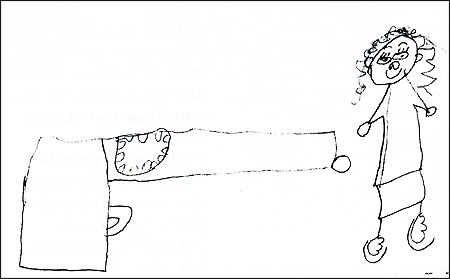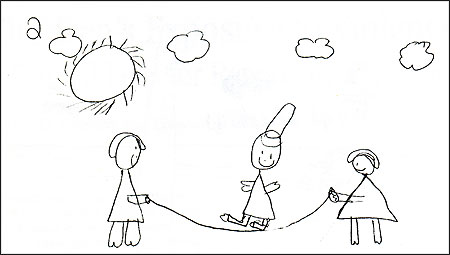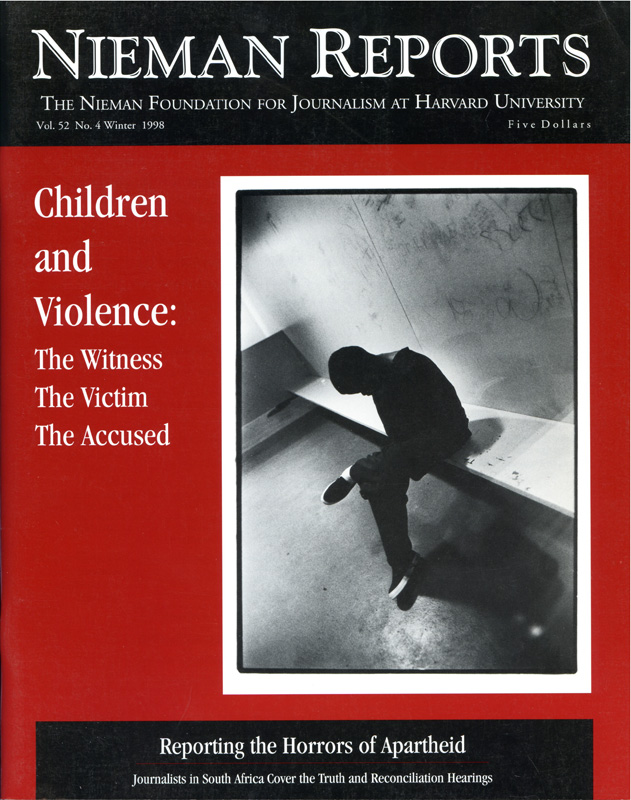
In therapy sessions, children use art to describe their lives. “Children in a Violent Society,” Edited by Joy D. Osofsky, The Guilford Press.
Each year in our country at least three million children are exposed to violence within their homes. These children are the victims of violence, even though scars are often invisible. Another several million children confront violence in their neighborhoods, and most children are exposed to scenes of violence on television or at the movies, on the Internet or in the lyrics of popular songs. These children’s stories deserve to be told. In fact, they need to be told, for within them reside valuable clues about the violence that comes to inhabit all of our lives.
From our vantage point—as researchers of and counselors to children who are exposed to violence—the roles media play can either be informed and beneficial or insensitive and harmful. For our children’s sake, we would hope that members of the media might pause to calibrate the effects of their work and learn about ways to improve their coverage of these issues.
Clearly the news media have as a primary responsibility the job of reporting what happens and, by necessity, do so while keeping an eye on ratings and circulation. Therefore, the media have an obligation to report violent crimes, but there are ways to do this in a responsible manner that help to educate the public. It is important that the media guard against sensationalizing and glorifying violence for if they don’t, then a numbing desensitization can occur. Youth, especially, can start to identify more with the perpetrators than the victims. And members of the media ought not to be afraid to report on what does work within the justice system and reiterate the message that those who do commit violent acts usually do bear the consequences of punishment for their behavior.
In addition to these basic guidelines, it is vitally important that those who report on violence spend time understanding the impact that exposure to violence has on children during their formative years. There is fallout from these early traumatic experiences, and the public needs to know this. Readers and viewers should also learn through media coverage that help is available for children who live in the midst of violence, and the public deserves to know that therapeutic approaches are working to minimize the consequences later on.
Unfortunately, there are many people—including some who report on violence in the media—who don’t know that young children are adversely affected by witnessing violence. Others believe the numbers of children who are affected by exposure to violence are small. However, scientific evidence about the traumatizing effects of such exposure is indisputable. Exposure to violence can determine how children process the experiences of their lives, how they behave in various circumstances, and how they respond to provocation. Children who endure chronic exposure to community violence and/or domestic violence are at increased risk of becoming violent themselves, in part because they have not had an opportunity during their early years of development to learn other ways of coping with the inevitable stresses of life.
Surveys are finding also that young children are exposed to violence at a much greater extent than many professionals realized only a few years ago. Research done at Louisiana State University Medical Center revealed that 51 percent of the children interviewed in two urban elementary schools in New Orleans reported they had been direct targets of violence while 91 percent of them said they had witnessed some type of violence. In other urban areas, surveys reveal similar results.
The implication for members of the media seems obvious to us: If violence is penetrating these children’s lives at such a pernicious pace, then vigilant coverage of its origins, impact and potential remedies is merited. There are important stories to be told of children who, with help, become resilient survivors as well as stories of circumstances in which the untended exposure during a child’s early years manifested itself in actions he took a decade later. We think this issue of exposure to violence offers a critical lens through which many stories about violence should be seen and heard.
Fictional violence, be it on television, at the movies or on the Internet, brings with it similar issues and concerns. Glamorization of make-believe violence is dangerous, and those who manufacture it must bear some responsibility when youngsters model the inappropriate behaviors they see portrayed in front of them. Whether it is in the imaginary world of film or TV or in the news media’s actual depiction of events, adults who convey stories about violence to audiences that are likely to include children should avoid characterizations that encourage risk-taking, promote the seeking of revenge, or possibly will lead to copycat behavior. One thing we know about children and adolescents is that they believe in their invulnerability: No message from the media should provide additional care and feeding of this belief.
There must be creative ways in which those who are in the business of depicting stories about violence can do so in more positive ways, without sacrificing ratings or profits. A search for alternative routes to reaching this goal is certainly warranted, given what we are learning about the dire consequences of staying the course.
Our experiences working with journalists convince us that such stories can be told and can hold the public’s attention. In our work with the Violence Intervention Program—a joint effort by LSU’s Medical Center and the New Orleans Police Department, its public schools, and community and neighborhood groups—we’ve worked with reporters who were willing to be educated about these issues, then translate their learning into interesting and informative stories. They begin by finding out about our community-based program, an initiative we designed with four goals in mind. We wanted to respond directly and empathetically to children and families affected by violence. We set out also to educate police who are called to respond to violence about the effects it has on children who witness it. We wanted to teach families living with violence how to keep their children safe. And we insisted on a rigorous evaluation of the effectiveness of our efforts.
In the five years the Violence Project has existed, it has put into place a 24-hour hotline for police officers and families and moved police officers through training sessions in which they learn about the roles they can play in helping children. Each year, counselors at the program provide thousands of hours of clinical services and consultations in schools with children, parents and teachers.
In 1995, a nine-year-old boy, James Darby, was brutally and senselessly murdered in a drive-by shooting while he was walking home from a picnic with his family on Mother’s Day. Just nine days earlier, after an interview at The Violence Intervention Program, James had written the following letter to President Clinton:
“Dear Mr. Clinton,
“I want you to stop the killing in the city. People is dead and I think somebody might kill me.
“Would you please stop the people from deading. I’m asking you nicely to stop it. I know you can do it. Do it now. I know you can.
“Your friend, James”
We’d promised James and other children that we’d send their letters to the President. After James’s murder, President Clinton released this letter to The Associated Press. Thousands of letters were then sent to us, some with postmarks from other countries. In the wake of James’s death, we gave countless interviews, watched as articles were published in the domestic and international press, appeared on radio and TV talk shows, and had a (CBS) Sunday Morning segment done about The Violence Intervention Program.
Although this intensive media coverage was exhausting for us and for members of James’s family, we were heartened by the fact that public awareness about violence was being heightened and news about positive efforts like ours was reaching the readers and viewers. Since then, local and national media have continued to return to James’s story and our program’s efforts to minimize the harmful effects of violence on children as a way of telling a story that can illuminate important issues. Through this experience of working with the media we have been able to more widely educate the public about youngsters’ behaviors that are linked to post-traumatic stress disorders brought on by exposure to violence. And our advice on the safeguards needed to protect children from witnessing violence has been picked up along the way. Colleagues of ours who operate similar programs in Boston and New Haven have also worked hard to persuade members of the media to stick around after their reports on violent events have been broadcast or published so they can see what happens to those children.
For the impact of violence on children to be reduced, the media’s focus needs to be taken off of unnecessarily graphic reporting of crimes and put on to the task of increasing the public understanding of the ways in which violence—and its depiction—can and does breed more violence. Our experience demonstrates that when members of the media take the time to be informed, their coverage can be beneficial.

“Children in a Violent Society,” Edited by Joy D. Osofsky, The Guilford Press.

“Children in a Violent Society,” Edited by Joy D. Osofsky, The Guilford Press.
Joy D. Osofsky is a Professor of Public Health, Psychiatry and Pediatrics at Louisiana State University Medical School. She has served for the past four years as the Founder and Director of the Violence Intervention Program that is affiliated with LSU Medical School. In 1997 her book, “Children in a Violent Society,” was published by Guilford Press. Since 1986, Howard J. Osofsky has been Professor and Head of the Department of Psychiatry, LSU Medical School, New Orleans, where he works to provide community outreach of mental health services to low-income children and families.



